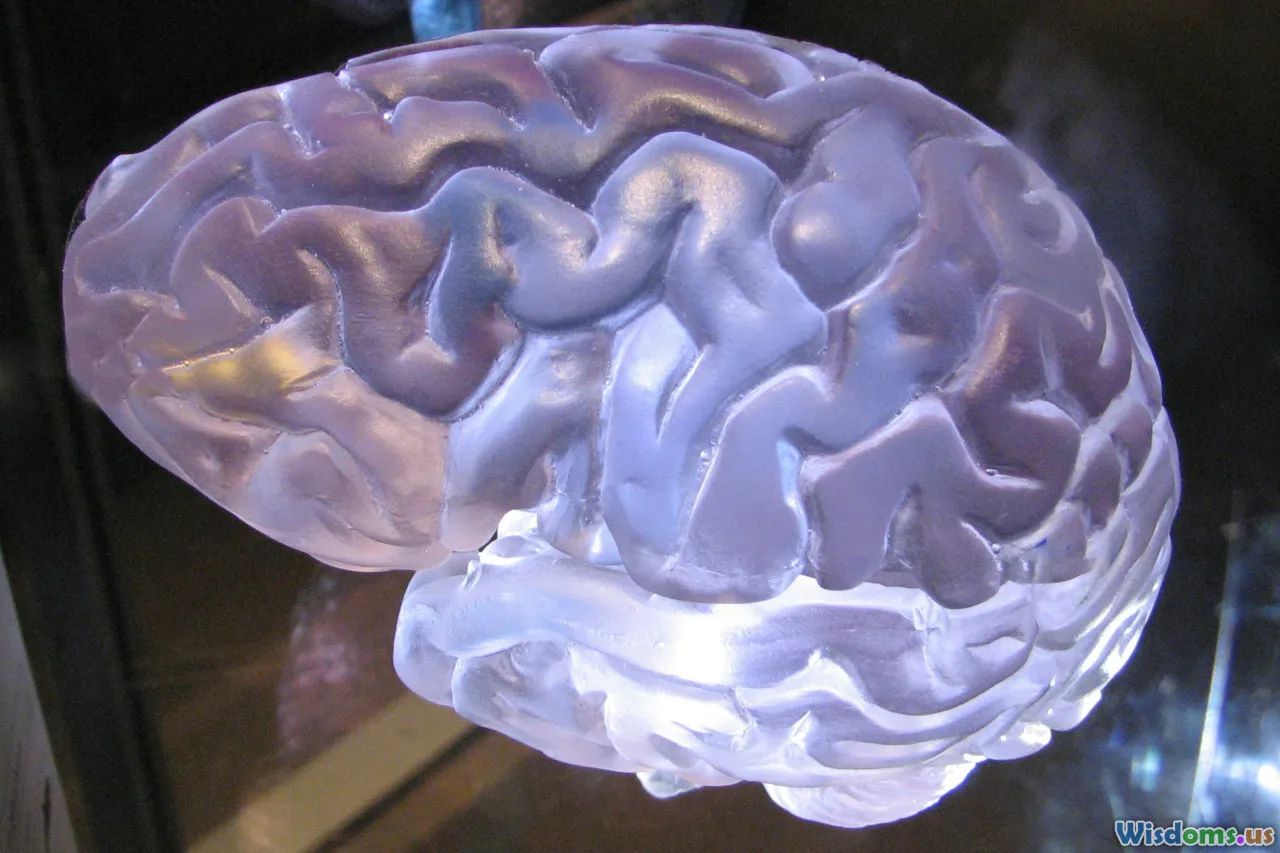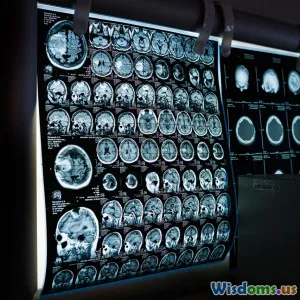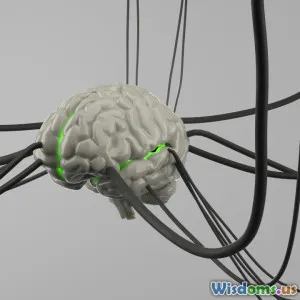
Do We Really Use Only Ten Percent of Our Brain
14 min read Explore the truth behind the myth that humans use only ten percent of their brains, backed by scientific research and neuroscience facts. (0 Reviews)
Do We Really Use Only Ten Percent of Our Brain?
Popular culture has long tantalized us with the alluring notion that vast portions of our mind lie untapped—waiting for a magic unlock. You've probably heard, on TV or in films, that humans use only "ten percent" of their brains, and that the other 90% remains dormant, an uncharted resource brimming with potential. But how much truth underpins this popular theory? And what does modern science have to say about the real limits—and possibilities—of our brains?
Let's probe deeper into the origins, scientific evidence, and enduring allure of the "ten percent myth," and discover what it truly means to maximize our neural potential.
The Birth of a Brainy Legend

Where did the idea that we use only ten percent of our brains originate? Fascinatingly, this notion took root in the public mind through a swirling blend of misinterpreted science, influential storytelling, and early brain research.
Misquoted Pioneers and Misunderstood Science
William James, a Harvard psychologist often hailed as the father of American psychology, famously stated in 1907 that "we are making use of only a small part of our possible mental and physical resources." Though James intended to spark curiosity and self-improvement, not to set a literal figure, a myth took shape.
By the 1930s, American advertiser Lowell Thomas, while promoting Dale Carnegie’s influential How to Win Friends and Influence People, paraphrased James as saying, “the average person develops only ten percent of his latent mental ability.” The sound bite stuck, feeding a century-spanning urban legend.
The Silver Screen and the Spreading of Misinformation
The appealing sound-bite snowballed, echoed in books, magazines, and movies. Films like Lucy (2014) built their plot around the premise that humans awaken superpowers upon unlocking more of their brain capacity. These stories kindle intrinsic hope—who wouldn't want untold mental abilities just an effort away?
Yet, as we often discover, reality is far more intricate than fiction.
Brain Science: A Reality Check

What does scientific analysis show about our actual brain usage?
The Full Brain Is Active
Modern neuroscience has unequivocally debunked the ten percent myth. Technologies like functional magnetic resonance imaging (fMRI) and positron emission tomography (PET) scans let scientists observe brain activity in real time.
Everyday Activity Involves Almost All the Brain
Even the most mundane acts—reading, laughing, moving your toes—engage diverse and sprawling regions of the brain. For example:
- Reading aloud: Requires the visual cortex (seeing), Broca’s area (speech), Wernicke’s area (language processing), and the motor cortex (mouth and tongue movement).
- Walking: Involves the cerebellum and both the left and right hemispheres for balance, coordination, and spatial awareness.
A comprehensive review published in Frontiers in Human Neuroscience (2014) concludes that "far from lying dormant, the cellular and metabolic activity occurs throughout the brain, even during sleep."
Localized Brain Damage Has Profound Effects
If 90% of the brain were superfluous, brain injuries would rarely cause major deficits. But even small strokes or localized brain trauma often lead to dramatic loss of function—demonstrating how densely packed with purpose every region is. For instance, lesions in the hippocampus greatly impair memory formation, while injury to the occipital lobes impairs vision, regardless of how little area is damaged.
Simply put, brains are not designed with significant excess.
Exploring the Ten Percent Figure: Origins and Misuses

Misinterpretations and Unfounded Beliefs
Why, then, did the ten percent idea stick so stubbornly? Studies indicate it is psychologically satisfying, offering hope for self-improvement. It's easy to buy the idea that if we could just "unlock" the other 90%, we'd achieve genius-level talent or extraordinary creativity.
The figure may come from misconceptions about brain structure:
- Glial Cells: Early neuroscientists learned that about 10% of the brain's cells are neurons, with the other 90% being glial cells. However, glia play critical support roles and do not equate to "unused" matter.
- Cerebral Efficiency: Some believed that since at rest, the brain uses around 20% of the body's energy, but not all neurons fire at once, maybe most neurons are inactive. But regions continually shift in activity, always working to maintain life or potential.
Neuroimaging’s Proof
Functional and anatomical brain imaging shows no "silent centers." PET scans show even during simple rest, the so-called default mode network (DMN) is busy with memory, introspection, and daydreaming. Clinical mapping procedures before surgeries, pioneered by Wilder Penfield in the 1930s-1950s, have revealed no dormant lobes. Remove or damage any region, and some task suffers.
Why Myths Linger: The Seduction of Untapped Potential

The Power of Hope
The ten percent myth is alluring partly because it taps into our collective hunger for self-improvement and unexplored potential. Who wouldn't want to believe they possess a wellspring of unused abilities, waiting for the right moment?
The self-help industry has capitalized on this allure, promising "secret" tricks to accessing diagonal thinking, genius, photographic memory, or even psychic powers. Popular books and motivational speakers routinely invoke the legend as evidence of latent greatness. But this narrative, however tempting, distracts from both brain science and the realities of cognitive improvement.
Neuroscience: Not Less Potential, But Hidden Complexity
While we don't have an unused cache of powers lying dormant, our brains are astonishing in their complexity and plasticity. For instance:
- Neuroplasticity: The brain's ability to reorganize itself by forming new neural connections throughout life. This is the science behind learning a new language, mastering a musical instrument, or recovering from injury.
- Cognitive Reserve: Some people show little effect from brain pathology (like amyloid plaques) thanks to mentally stimulating lifestyles, education, and engagement.
Instead of focusing on unlocking unused territory, the quest should be on cultivating growth, resilience, and adaptability.
What Science Reveals About Cognitive Enhancement

Maximizing Real Mental Potential
If the myth is busted, what's the true path to greater intelligence or skill?
Deliberate Practice
Research by Anders Ericsson and others on expertise shows that purposeful, well-structured practice trumps mere repetition. Skills—from chess to chess or violin—result from extended, deliberate engagement, not hidden lobes suddenly awakening.
Lifelong Learning and Enrichment
Regularly challenging your mind—through reading, puzzles, new experiences, or conversation—helps sharpen reasoning, improve memory, and even stave off age-related decline.
A 2022 study published in Lancet Public Health links ongoing intellectual engagement and physical activity to reduced risk of dementia. Mental activity doesn't "switch on" dormant brain areas, but instead strengthens connections, builds resilience, and enhances adaptive capacity.
Physical Health Matters
Factors like sleep quality, exercise, diet, and stress level crucially modulate brain function. The ten percent myth overlooks how the brain's performance is inextricably tied to systemic health. Aerobic exercise, for instance, increases the release of growth factors beneficial for long-term memory and neuroplasticity.
The Limits: No Free Superpowers
No credible scientific technique exists for "unlocking" lost brain areas. Success stems from harnessing the complexity we already possess, not awakening hidden segments. Commercial brain-training apps may improve performance on repeated tasks but lack evidence of boosting broad intelligence.
Brain Power in Numbers: Some Interesting Facts

- Over 86 Billion Neurons: Each forming up to 10,000 connections. That’s roughly 100 trillion synapses—far more than the stars in our galaxy.
- 20% of Energy: The brain uses a fifth of daily calories even though it accounts for about 2% of body weight.
- Always Active: PET and fMRI studies demonstrate global brain activity at any moment, ebbing and flowing by region depending on tasks and states (awake, asleep, focused, daydreaming).
- Brain Reserve: Studies of stroke, epilepsy, and tumor patients show how even small injuries can have outsized impacts, and how the brain sometimes enlists adjacent regions to compensate in recovery.
- No "Silent Centers": Neurosurgeons electrically stimulate every accessible part during certain surgeries—none are non-functional in healthy brains.
Actionable Advice: Boosting Your Own Neural Edge

Given what we know about true brain physiology, here are practical ways anyone can maximize their cognitive prowess:
- Challenge Yourself Regularly: Learn a new language, musical instrument, coding skill, or take up chess. Such tasks engage wide-ranging regions of gray matter and boost integration.
- Stay Physically Active: Exercise isn’t just about the body—physical movement increases blood flow and releases neurotransmitters vital for memory and mood.
- Prioritize Sleep: Sufficient, high-quality rest helps consolidate memories, purge metabolic waste, and enhances creative problem-solving.
- Cultivate Social Connections: Dynamic conversation activates complex cognitive and emotional processing networks. Social isolation has negative effects on brain health.
- Manage Stress: High, chronic stress impairs prefrontal cortex functions like planning, attention, and emotion regulation. Regular relaxation and mindfulness practices can restore balance.
- Feed Your Brain: A Mediterranean-style diet rich in fatty acids, antioxidants, and lean protein helps protect structure and function.
Practice these and you'll notice the difference—not by magically "unlocking" hidden powers, but by leveraging your full, working neural capacity.
The ten percent myth has held sway over the popular imagination for decades, promising superhuman intelligence just out of reach. Science, however, reveals something even more astounding: every region of our brain is alive with purpose, and each moment of living calls upon full, dynamic neural engagement.
So rather than hunting for a magic unlock, embrace the remarkable gear that’s already whirring away inside your skull—ceaselessly, day and night. The real miracle? You're already using enough brain power to imagine, aspire, learn, recover, and persist. And with healthy, daily investment, you’ll keep on unlocking potential, one circuit at a time.
Rate the Post
User Reviews
Other posts in Neuroscience
Popular Posts


















